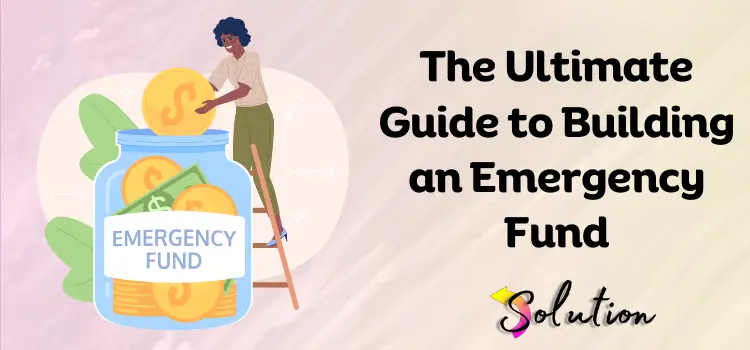
In our uncertain world, having an emergency fund is not a suggestion but necessary. You can use it as a safety net to avoid debt due to unexpected medical bills, vehicle repairs, lost wages, or urgent house maintenance. Putting money aside for an unexpected expense could be challenging when you’re already strapped for cash or have a lot of debt. If you follow a defined plan and have a disciplined attitude, you may build a substantial emergency fund that will protect you financially from life’s unexpected events.
Creating an emergency fund might be daunting, but this comprehensive guide will show you the ropes. By the end, you will have the knowledge and skills to build a financial safety net that will provide you joy and stability in the coming years.
An Emergency Fund: What Is It?
Establishing an emergency fund is one way to prepare for life’s unexpected costs. True crises threatening your financial stability should be the only recipients of these funds, they are not for scheduled purchases or frivolous spending like holidays.
According to most financial experts, a three- to six-month supply of living expenses is the recommended minimum amount for an emergency fund. The stability of your employment, the size of your family, and your health are a few factors that can affect this.
What Is the Purpose of an Emergency Fund?
There are several ways in which an emergency fund might save you from financial hardship:
- Having a cash reserve allows you to avoid taking out loans, using credit cards, or withdrawing money from your retirement plans, all of which can lead to interest and penalties when an emergency occurs.
- Having an emergency net makes it much easier to deal with unforeseen costs.
- Persisting in pursuing distant objectives: If you don’t have money set aside in case of an unexpected need, you could have to borrow or liquidate investments to get back on track financially.
Step-by-Step Guide to Building an Emergency Fund
Creating a budget to determine how much you can realistically save each month is the first step in building an emergency fund. Once you clearly understand your income and expenses, you can set a specific savings goal to work towards.
1. Decide How Much Money You Want to Put Into an Emergency Fund
Establishing a reasonable savings goal is the initial stage in amassing an emergency fund. The standard advice is to put away enough money to cover three to six months of living expenses, but no universal rule applies here. The best amount to put away in an emergency fund is situationally and contextually dependent.
- Maintaining one’s employment: While three months’ worth of living expenses might be sufficient for someone with stable employment, those who are self-employed or work in an industry that frequently layoffs should have at least six months’ worth.
- Diseases and ailments: Strive for greater heights if you or a loved one regularly incurs substantial medical bills.
- Those who rely on it: A larger emergency fund is preferable if you have a significant number of dependents on your income.
The Best Way to Estimate Your Monthly Bills
In order to establish a budget, you must first determine your monthly essential expenditures. Classify things like:
- Residential (rent/mortgage)
- Power and water
- Food Items
- Transportation options include auto loans, petrol, buses, and trains.
- Health, vehicle, and house insurance
- Paying off debt, including credit card and student loan debt, is a priority.
- Medical expenditures (drugs, doctor appointments)
- Other necessities include childcare and minimum retirement contributions.
Knowing how much money you’ll need each month will help you determine how long you should set aside in an emergency. For example, if your monthly basic needs are $2,500 and you want an emergency fund covering six months, you must save $15,000.
2. Establish an Individual High-Yield Savings Account
Avoid spending your emergency fund by keeping it distinct from your ordinary checking account, even if it should be immediately available. If you’re looking for a way to save for unexpected expenses that are both accessible and earn more interest than a standard savings account, a high-yield savings account (HYSA) is a fantastic choice.
Consider the following factors when selecting a high-yield savings account:
- Rate of interest: Shop around for an account that offers a competitive APY.
- Account accessibility: Make sure you can quickly access your money in an emergency, but not so easily that you withdraw hastily.
- Never open an account with a monthly maintenance fee or a withdrawal penalty.
3. Efficiently Automate Your Savings by Starting Small
If putting away enough money to cover a few months’ costs is too daunting, try saving $500 or $1,000 instead. Any savings, no matter how tiny, is preferable to none in case of an unexpected expense.
Establish a regular schedule to add to your emergency fund when you’ve decided what you want to achieve. Automatic savings are the best way to save money consistently without thinking. Every week, even $50, will build up.
One way that automated savings can accumulate over time is as follows:
- Fifty dollars a week equals $2,600 a year.
- The annual cost is $5,200, or $100/week.
- Spending $200 weekly equals $10,400 annually.
The important thing is to establish a habit of saving, no matter how little the initial contributions are.
4. Discover Ways to Cut Costs and Increase Savings
Reevaluating your spending patterns and budget may be necessary if you’re having trouble finding additional funds to add to your emergency fund. Consider the following options to free up your cash flow:
- Review your monthly subscriptions (to streaming services, gym memberships, etc.) and cancel the ones you don’t use.
- Home cooking: Going out to restaurants can be expensive. Eat more healthily and spend less on groceries by making more of your meals and preparing them in advance.
- Cut down on energy costs: To reduce your power and water expenses, switch off the lights, unplug electronics, and change the thermostat a few degrees.
- Find better deals: To lower your grocery bills, stock up on generic brands, use coupons, and shop during specials.
- Reduce splurging on unnecessary purchases: Cut back on spending on things like clothing, electronics, and entertainment that aren’t necessities.
Efforts to increase your income can also help your emergency fund. Consider freelancing, selling household items you no longer need, or getting a second job.
Recent Post:- Five Simple Habits for a Healthier Lifestyle in 2024
5. Put Savings and Paying Off Debt First
Responsible debt management is essential while saving for an emergency fund. Credit card bills and other forms of high-interest debt can quickly add up and wipe out any savings you may have made. Keep spending in check while you pay off your debt.
- If your interest rates are 10% or higher, pay off your high-interest debt as quickly as possible while setting aside a little money for emergencies.
- Raising payments to your emergency fund is a beneficial next step after paying off high-interest debt.
Conclusion
For financial security, saving for an emergency fund is crucial. Achieving your goal will require time and effort, but it is possible with little steps, savings automation, and self-discipline. In addition to helping you weather difficult times, having an emergency fund allows you to focus on your long-term financial goals without worrying about meeting short-term ones.
This blog shows how to build a financial cushion as your first defense against life’s unpredictability. Get a head start now you’ll be glad you did in the long run.


